Lab-to-Lab: US-Russian Lab-to-Lab Collaboration Story [Archived]
Early Lab-to-Lab | Export Control | Nielsen Jr. | Symposia | WSSX
Physics | Reminiscences of Russia | Caroline (Cas) Mason
- Setting the Stage
- Forming Collaboration
- Frequent Experimental Campaigns Part 1
- Frequent Experimental Campaigns Part 2
- Broadening and Declining Collaboration
- Restoring Collaboration
- Epilogue 2006-2016
- Concluding Remarks
The 1997 enthusiasm for expanded collaboration had all but dissipated by 2000. A mid-level LANL manager who had described himself as “too much of a Cold Warrior to want to work with Russians” had almost abruptly cancelled all funding for collaborative activities. Fortunately, Undersecretary of Energy Moniz met with his Russian counterpart, Lev Ryabev, and subsequently asked LANL and other U.S. laboratories to increase interactions with the Russian labs. Therefore, trips to VNIIEF in 2000 and 2001 were devoted to restarting nearly cancelled projects and initiating new ones. The year 2000 would become the only year since 1993 that VNIIEF and LANL did not conduct at least one joint experimental campaign.
Bureaucratic impediments continued to grow. Getting U.S. and Russian government approval to travel to Sarov was becoming more difficult, leading to trip postponements or cancellations. Security restrictions on LANL delegations in Sarov reverted to those encountered in our early visits (apparently the law that foreigners were prohibited in Sarov had remained on the books), and many of the social interactions with the Sarov community that had made previous trips so enjoyable were now prohibited.
The Russian government actually denied approval for representatives of many U.S. programs to enter Sarov. Fortunately, our pulsed-power-based high-energy-density physics collaboration was still able to get access, often only after heroic efforts by our VNIIEF hosts, and we interpreted this access as an indication that Russia continued to desire such collaboration. In June 2001, Rickey Faehl, who worked part-time on the Nuclear Cities Initiative (NCI), apparently became the first person associated with the NCI in eighteen months to enter Sarov and conduct NCI business; presumably, if Faehl had not also been involved in the HEDP collaboration, he would not have received access permission.
June 2000
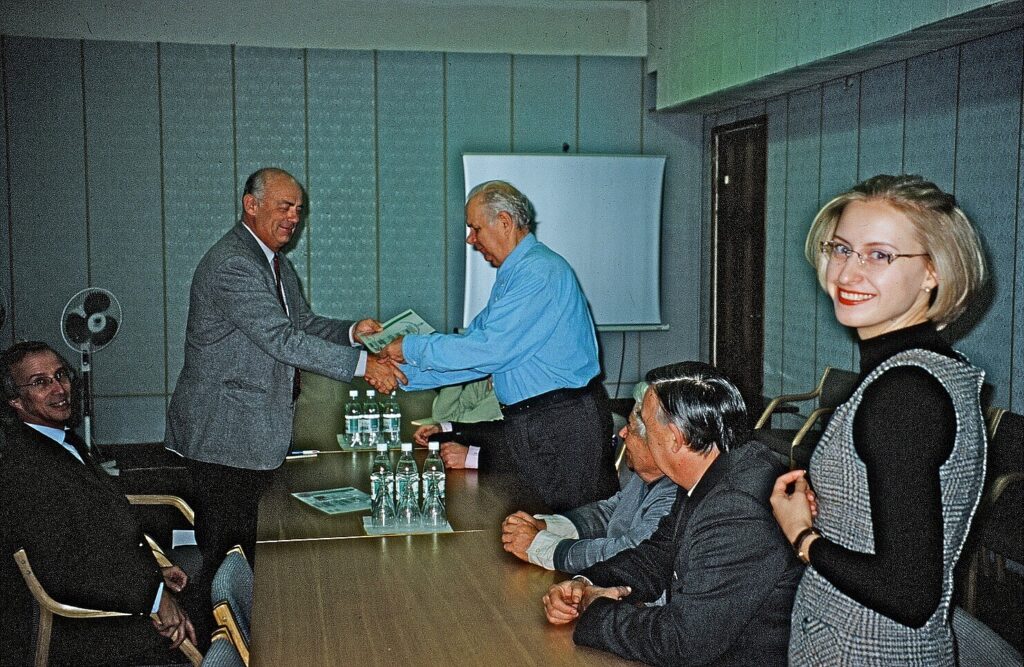
I.D. Sofronov (standing, right) presents the author with a certificate indicating membership in the International Informatization Academy. Reinovsky (left) and V.N. Mokhov (sitting, right) look on (Sarov, November 2000).
In Sarov to review past projects and begin to implement the Moniz/Ryabev agreement, Clark, Faehl, Reinovsky and me were inundated with questions regarding the Wen Ho Lee affair, the May 2000 Cerro Grande Fire that had delayed our original departure, and the LANL missing hard drives that allegedly contained classified information. On the subject of the missing hard drives, which had been reported missing during our time in Sarov, we learned more than we knew. It was obvious from comments made that this incident had received extensive coverage in the Russian news media.
November 2000
Bob Reinovky and I returned to Sarov to continue the process started in June 2000. Whereas high-ranking VNIIEF leaders had always participated in the joint activities, their LANL counterparts had been for the most part conspicuously absent. Therefore, to demonstrate LANL’s commitment to the Moniz/Ryabev process, we had enlisted two division managers and a program manager to join us. Unfortunately, at the last moment, all three had to cancel due to a combination of work obligations, personal commitments, and sudden illness, something we considered to be really bad luck. Although all three expressed intentions to travel to Sarov at the earliest possible date, LANL management changes precluded such visits, and LANL upper leaders remained conspicuously absent.
Bob and I were accorded quite an honor when we were given certificates indicating that we had been inducted into the International Informatization Academy after nomination by our VNIIEF colleagues. Although we have never really understood the function of the academy, we were thrilled because we knew our colleagues considered it an honor.
June 2001
A nine-member team (Anderson, Atchison, Clark, Faehl, G. Rodriguez, Stokes, Tabaka, Westley, and myself) returned to Sarov in May and June to conduct the second experiment using VNIIEF DEMGs to emulate the Atlas capacitor bank. The experiment had been delayed from early April first because of heavy late-winter snowfall caused soggy and unsafe firing point ground and then because of U.S. travel regulations.
The late thaw and much remaining moisture in the forests surrounding Sarov and the firing point made conditions perfect for a terrible infestation of mosquitos and gnats. The experimental team was accosted by these insects whenever their activities required them to work outside, even though they applied mosquito repellent and wore long sleeved shirts, high collars, and hats. The buzzing noise of the insects within the protective plastic sheeting “house” placed over the experiment to protect it from rain was deafening.
Although cautionary steps were taken to prevent the insects from entering our hotel rooms, it was not uncommon to be awakened in the middle of the night by mosquito buzzing or a mosquito bite. Invited by Lydia Ilkaeva to play tennis, Faehl and I were immediate victims of a vicious attack from the gnats and mosquitos that hid among the foliage surrounding the tennis courts and we received numerous bites that festered for nearly a week after their return to the US.
The growing relationship between the medical professionals in Sarov and Los Alamos had reached a point where doctors in both cities were quite familiar with each other. On this trip, this growing medical relationship had a direct impact on our team. Stokes required treatment for a swollen foot that became evident on the trans-Atlantic flight to Moscow. A week later, fours hours away from Sarov by train, Atchison began to experience pain that had become so severe by the time we arrived in Sarov that we insisted that he immediately be transported to the Sarov hospital. In both cases, we and the Sarov physicians consulted by phone and e-mail with Los Alamos physicians for diagnosis and recommended treatment. Much to our comfort, the Los Alamos doctors confirmed the diagnosis and approved the treatment. Stokes had an infection and Atchison had kidney stones, both the type of ailments that travelers dread when far from home. Fortunately, both received excellent care. Stokes rested in the hotel for five days and Atchison was hospitalized for three.
Stokes and Atchison were insistent that they make a fair and reasonable payment for their treatment, an insistence that continued for many days when no bill was forthcoming. It became apparent that the insistence on payment and receipt was causing a great deal of administrative headaches. The deputy head of the Sarov medical services strongly emphasized that in Russia, by law, emergency treatment is rendered free of charge; there simply was no way whatsoever that the Sarov hospital could submit a bill and receive payment. After considerable further discussion, the Sarov physicians reluctantly agreed that the hospital would accept a “personal donation” which would be used to benefit the medical center.
En route to Moscow, Faehl had been assigned an airplane seat next to Glen Schweitzer who had been the first director of the ISTC. Schweitzer expressed dissatisfaction and disenchantment with most U.S./Russian initiatives in the nuclear arena and stated that, in his opinion, only the “lab-to-lab” scientific cooperation and non-government-run Sister Cities interactions were giving cost-effective results, sentiments that certainly meant a lot to our delegation.
Because the experiment was not conducted until 11:36 P.M. and the team did not even return to their hotel until nearly 1 AM the next morning, the LANL team had assumed that the traditional celebratory banquet that had been scheduled for earlier in the evening had been cancelled. A quick inquiry confirmed the Americans’ worst fear: the banquet was not cancelled. Suggestions to delay until the next morning or noon (the team was scheduled to depart from Sarov the next afternoon) and arguments to cancel—extremely tired people, a long trip ahead, etc.—all went for naught, so four Americans and about a dozen Russians attended a very subdued banquet that began at about 1:30 AM and ended at 3 AM.
July 2001
As noted earlier, George Crile, CBS 60 Minutes producer and author of Charlie Wilson’s war, had accompanied the LANL team to Sarov in August 1998. In July 2001, a VNIIEF delegation and members of the LANL team were participating in a scientific conference in Las Vegas. When I phoned Crile to tell him that a VNIIEF delegation was in Las Vegas, he hurriedly ordered a local camera crew to the conference site. He then flew to Las Vegas and then traveled by automobile to Los Alamos with the LANL/VNIIEF team, with stops at Hoover Dam, Grand Canyon, Meteor Crater, and other sites along the route.
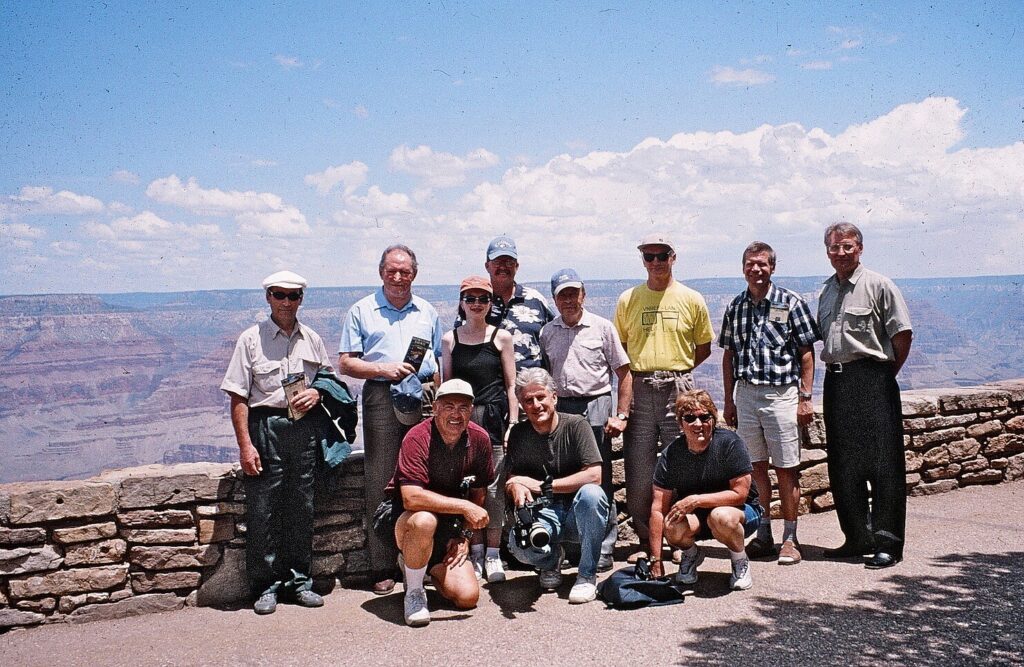
George Crile (center front) with LANL/VNIIEF team at Grand Canyon (July 2001).
In January 2003, Crile wrote to me confirming his continued determination to make a documentary about the LANL/VNIIEF collaboration,
I’m afraid I’m forever appealing to you for patience in thinking about me and whether or not I am for real in terms of ultimately intending to deliver something that could share with our audience the grand work that I have partially chronicled. It’s been something of an indecent interval on my end in terms of not yet putting something together. Nevertheless I would like you to know that you and your Russian-American colleagues remain very much alive in my thoughts. And although I don’t, at the moment have something tangible to tell you about my plans, I still believe that I will come through in the end. The stories I invest in, more often than not, tend not to be diminished by the passage of time. I think that’s the case with your adventure. I see it as a towering tribute to something glorious and beyond the science, which is not to be diminished in its significance, there is simply the clear and powerful message about mankind’s capacity to see things differently and to change and to find a way to be of benefit to each other.
Unfortunately, Crile was to die prematurely in 2005, and any thoughts he had about documenting the collaboration died with him.
January 2002
The visit to Sarov by Atchison, Faehl, Reinovsky, Stokes and myself for a data review and planning coincided with the tenth anniversary of Bob’s and my first visit to Sarov in January 1992. Our hosts arranged a celebratory banquet attended by VNIIEF leaders and key collaboration participants. Numerous toasts and reminiscences of the first visit were offered. Director Ilkaev offered the first toast and said, prophetically, that a book should be written on the professional and personal experiences of the team. We certainly did not know that Doomed to Cooperate would become a reality a decade-and-a-half later.
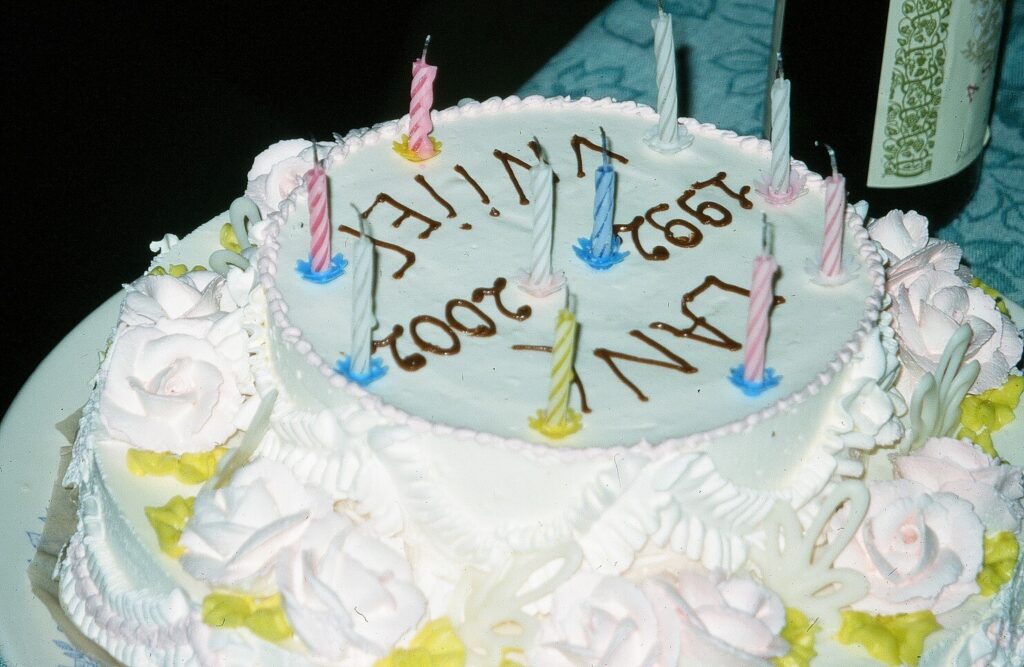
A cake commemorates the first decade of LANL/VNIIEF collaboration (Sarov, January 2002).
VNIIEF had prepared certificates signed by Ilkaev, Chernyshev, Mokhov, Reinovsky, and myself. The certificates had a place for LANL Director Browne to sign on our return to the US. According to the certificates, “this certificate confirms that” Lindemuth and Reinovsky had, on January 20, 1992, laid the foundation for productive and mutually beneficial collaboration in the field of super powerful magnetic explosive energy sources and the use of pulse power in scientific research between the All-Russian Scientific Research Institute of Experimental Physics and the Los Alamos National Laboratory.
Certificates for the others indicated that they had made a significant contribution to the development of joint fundamental scientific research in the field of high energy density physics and in the establishment of productive collaboration between the All-Russian Research Institute of Experimental Physics and the Los Alamos National Laboratory.
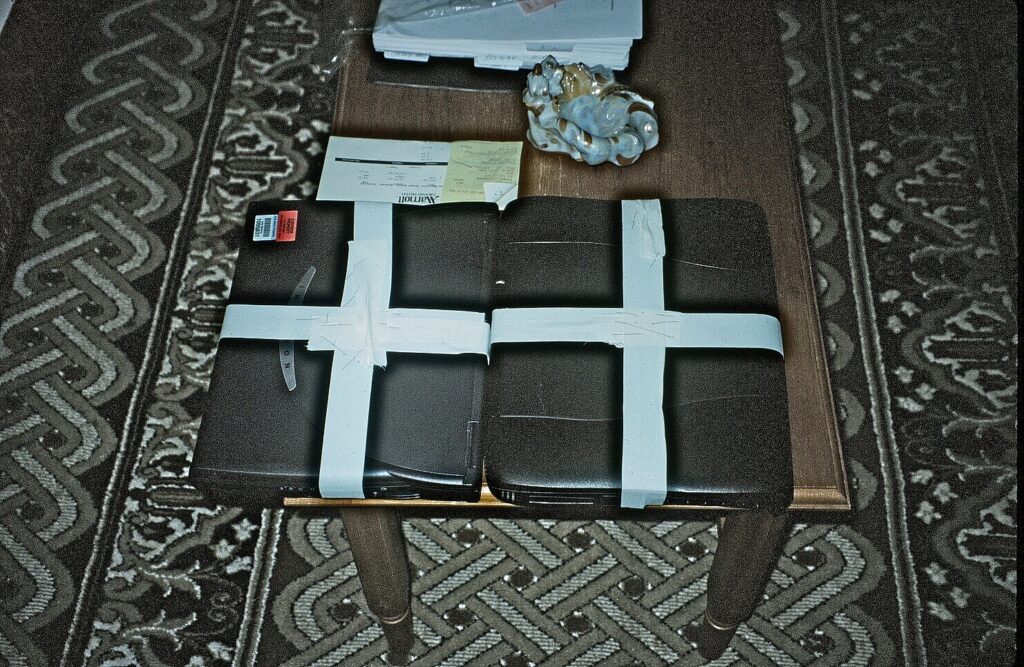
LANL computers heavily taped before being turned over to VNIIEF security (January 2002).
VNIIEF security regulations governing LANL computers ebbed and flowed throughout the first decade of collaboration. Sometimes, computer use was permitted only in the hotels, other times there were no restrictions, and, this time, computers were almost confiscated. VNIIEF security regulations required us to turn the computers over to security personnel, but I resisted, saying that LANL regulations prohibited us from giving up possession. A compromise was reached whereby we heavily taped our computers and turned them over to security personnel, who assured us the computers would remain locked in the hotel’s safe.
Los Alamos friends and colleagues had questioned why our delegation would want to travel to Russia in the middle of January, particularly when the Sarov temperature had dropped to -30 degrees Fahrenheit earlier in the month. Approximately two feet of snow covered the ground on our arrival, and snow fell on many days of our visit, but temperatures were barely below freezing and some heavy rain melted much of the snow, so we escaped Russia without experiencing a true Russian winter.
January 2003
NNSA Administrator Gordon met with Ryabev in April, 2002, and had done what Reis, and Moniz had done before: signed a protocol espousing expanded collaboration of the type Russia’s scientific leaders had said many times prior was needed. Ed Heighway, LANL’s principle associate laboratory director for weapons physics, recognized that a concerted effort was required to meet the goals of the Gordon/Ryabev agreement and appointed me to be LANL’s point-of-contact for the process. Through the next year or so, I formed a cadre of principle investigators who were well recognized by the Russian experts in their fields and hence considered worthy collaborators.
A January 2003 trip took LANL delegations to VNIITF (Atchison, James Kamm, Dean Preston, Reinovsky, William Rider, Marvin Zocher, and me) and VNIIEF (Atchison, Goforth, Kamm, Reinovsky, Todd Urbatsch, Zocher, and me) to establish Gordon/Ryabev projects. All of the Russian leaders with whom we met were emphatic that the new relationships must be long-term, in contrast to the many small projects that had previously been defined more or less on a yearly basis. One result of this visit was that Kamm re-established the “5-lab” computational meetings. Five highly successful “5-lab” (LANL, LLNL, SNL, VNIIEF, VNIITF) computational workshops had been held (in 1992, 1994, 1995, 1996, and 1997) before being mysteriously (to the Russians) stopped when the DOE head of the Advanced Scientific Computing Initiative directed that none of the funds originating in his office could subsequently be used to support such workshops.
Cold but bright days were experienced at VNIITF, but the weather in Sarov was pretty much the same as a year earlier (so similar that an identical paragraph appears in our two trip reports), so once again we escaped from Russia without encountering the cold for which Russia is noted.
October 2003
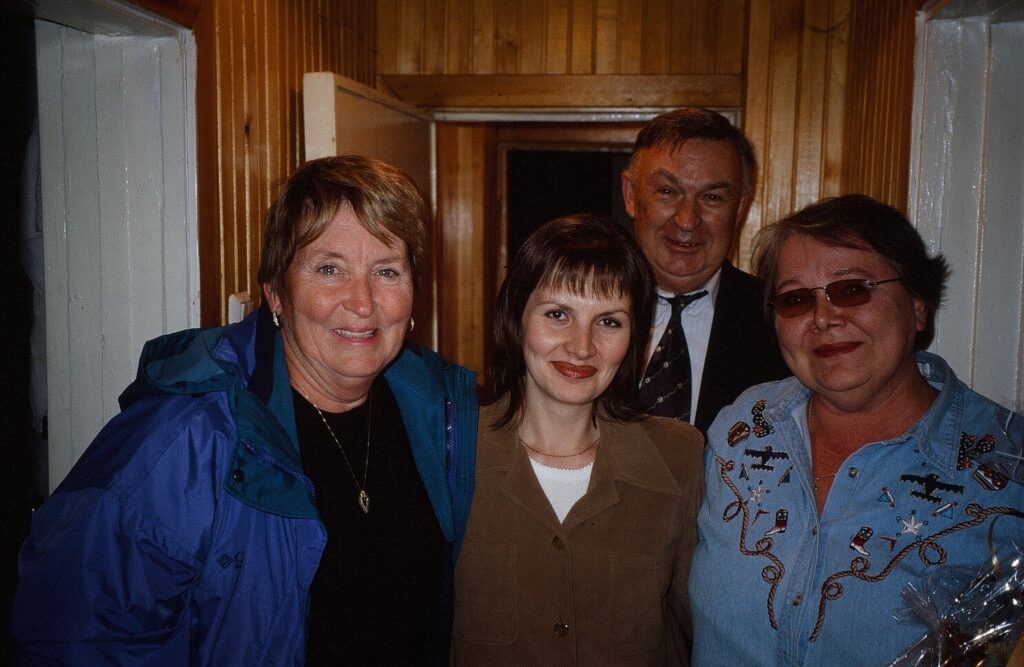
Hedy Lindemuth (left) visits the home of Vladislav and Tatiana Mokhov (right); VNIIEF interpreter Rimma Zubaerova is in the center (Sarov, October 2003).
I made my last trip to Russia as an employee of LANL, this time to participate in the Sarov Supercomputing Seminar. This trip provided an opportunity for my wife, Hedy, to visit Sarov for the very first time and to get a feel for the city that had been so important in my career for the last decade or so. She was to experience the legendary Mokhov hospitality, visit the house of General Negin, and tour the Sarov museum.
November 2003
I had retired from LANL in November, 2003. For two months prior, having sold our Los Alamos home and having moved our possessions to Tucson, Arizona, Hedy and I lived in borrowed or rented quarters as I tried to bring my time at LANL to closure. My discussions with LANL senior leaders regarding expanding LANL’s role in the Moniz/Ryabev (now Gordon/Ryabev) process seemed to fall on deaf ears.
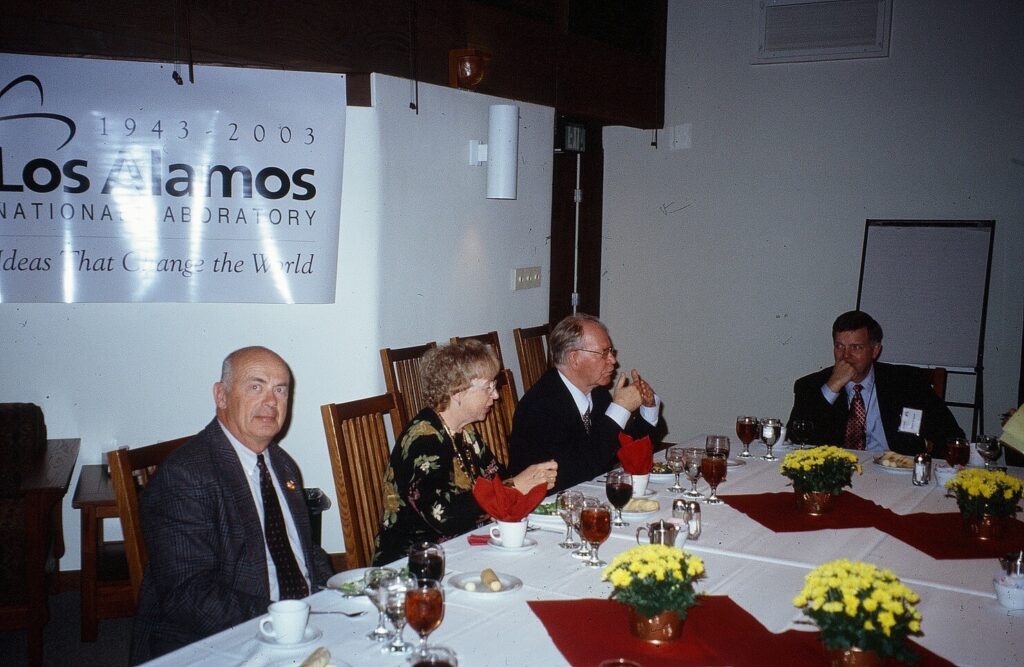
The author (left) attends LANL banquet in honor of Lydia and Radii Ilkaev (center, hosted by former LANL Director P. Nanos (right) (Los Alamos, November 2003).
Whenever the VNIIEF team visited LANL, an attempt was made to return the hospitality always extended in Sarov, and such attempts often included excursions outside the city. A November excursion to Albuquerque was unique for Vladislav Mokhov. Just one week prior to my retirement, I and Olga Augustson, as interpreter, accompanied Mokhov to the Albuquerque Heart Hospital for an examination by Dr. Barry Ramo, a noted television personality as well as noted physician. Mokhov’s prognosis was not good, and the very next day hospital surgeons performed angioplasty and installed stents in Mokhov’s arteries. Mokhov was back in Los Alamos within two days, participating in technical discussions and proudly showing off a bruised leg where his angioplasty catheter had been inserted. Perhaps because of the stents, Mokhov lived for another 8 years.
As my very last official duty at LANL, “working” until late in the evening of my very last day, I attended a banquet hosted by LANL’s director Nanos and held in honor of Radii and Lydia Ilkaev, who were visiting LANL. A toast or two and several comments were made to me commemorating my role in the LANL/VNIIEF collaboration, a fitting end to the most exciting and rewarding part of my career at the U.S. national laboratories.
Next >> Epilogue 2006-2016 >>
